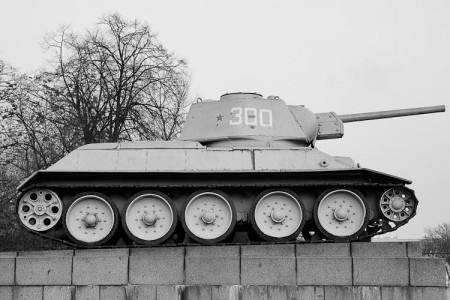
When cycling through the Strasse des 17. Juni (June 17th Street), which is a famous boulevard through Tiergarten, reaching from the Brandenburger Tor, via the Siegessäule towards the Ernst-Reuter-Platz, you may have two easy questions: Which June 17th is commemorated and what has happened that such a long central road holds this date?
It is the year 1953
After world war 2, Germany was divided into four allied occupation zones. The three western zones, controlled by the US, France and Britain, formed the Federal Republic Germany (FRG, BRD), also known as West Germany. The Eastern sector, controlled by the USSR, formed the German Democratic Republic (GDR, DDR), also known as East Germany. West Germany developed as a capitalistic state, East Germany transformed into a socialistic regime influenced by the USSR. Berlin was divided into four sectors as well, controlled by the same states, resulting in West Berlin (British, French and American sector) and East Berlin (Russian sector).
Although the cold war had just started (borders were still open, the ‘rules’ were not clear yet), differences between east and west were already noticeable. Whereas West Germany got to its feet relatively fast, in East Germany the forced implementation of socialism did not work out well for the economy. People were poor, and prices rose due to shortcomings.
Strike
To show the whole world and especially the capitalistic west the ingenious socialistic building quality, the DDR regime had put a lot of money into construction work such as the prestigious buildings along the Stalinallee (today the Karl-Marx-Allee). You were supposed to be proud to be a construction worker in the DDR. Whereas, after Stalin’s death in march 1953, the DDR regime recalled some strict socialistic measures in many sectors, the construction work quotas increased by 10%, which made the construction workers lay down their work on June 16th 1953 and march down the Stalinallee towards Alexanderplatz and the government area. The strike was successful and the government recalled their plan on the same day.
June 17th 1953
The news about the strike went fast, and a giant uprising could not be stopped. As the new system, arranged by the Soviets, was not the East-German idea of a socialistic state, there was a common feeling of suppression. On June 17th, about 0.5 to 1,5 million people took part in a widespread uprising against the DDR regime, and demanded free elections and resignation of the government. More generally, people demanded freedom and democracy, and in the end people wanted unification with West Germany. People were hopeful. The death of Stalin made people feel that even powerful dictators can be vulnerable. Maybe the situation could change. Streets were filled with people marching towards the govermnent area near Potsdamer Platz. Many small fires were started and Red flags were torn down. The government was afraid and the Volkspolizei could not control the situation. Finally, the uprising was suppressed by Soviet troops and the Volkspolizei: there were 25 to 500 deaths (official numbers depending on the regime), thousands of people were arrested and it resulted in a huge amount of refugees from the DDR.
Only 8 years after being the big liberator, the Soviets had become the enemy. The East German population had no chance. The Soviets showed how far their influence reached, the western countries did not take action, as a third world war should be avoided at any costs, and the rules of the cold war became painfully clear.
Strasse des 17. Juni
To commemorate the uprising, June 17th was exclaimed as Tag der deutschen Einheit (German Unity Day) in West Germany, which was a national holiday until 1990 (since the unification of Germany it is celebrated on October 3). Also, the Berliner Strasse and Charlottenburger Chaussee were renamed into Strasse des 17. Juni and it still has its name. By the many events and celebrations which are held on this road, it has become a symbol of freedom.
Ironically, there are two Red Army tanks placed at the Strasse des 17. Juni. These were already here as part of the Soviet memorial of the victory over the National Socialism after the Battle of Berlin, another restless period in the recent history of Berlin.

Congrats on your Berlin blog! Nice photos and interesting background information